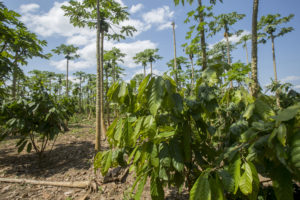Restoring the most ecologically valuable forest ecosystems in the world, by Natasha Ferrari, Communications Officer, Global Restoration Initiative, World Resources Institute (WRI).
The Tambopata-Bahuaja Biodiversity Reserve project has been featured in a chapter of the recently released ‘A Better World: Life on Land’– a partnership between the Human Development Forum at Tudor Rose and the United Nations. This book is dedicated to the Sustainable Development Goal ‘Life on Land’ and particularly to the sub-goal 15.3 which aims to achieve Land Degradation Neutrality globally by 2030. It gives an overview of the significance of these global goals, the main elements and challenges as well as highlighting good practices of projects that are helping to achieve land degradation neutrality.
The chapter ‘Restoring the most ecologically valuable forest ecosystems in the world’ showcases the work of Tambopata to restore land by working with local communities to develop sustainable agroforestry systems and to secure access to high value markets through the cocoa processing facility as a successful example in practice. It also explains how companies putting a price on carbon funds this critical work through the purchase of carbon credits which are generated when the threatened forest is protected. Below are some excerpts from the chapter.
“The Tambopata National Reserve in the Madre de Dios region of Peru is located between the fringes of the Amazon rainforest and the city of Puerto Maldonado. The land here had become degraded through both illegal mining and the single crop plantations of papaya that provided the community with much needed income but stripped the soil of nutrients. This type of practice led to deforestation as farmers moved on in search of new plots of nutrient-rich land, often forested. These scenarios are rapidly changing due to a groundbreaking project to transform agriculture in the southeastern region of Peru run by local, non-governmental organization AIDER…”
“AIDER is working with the local community and farmers to restore land and incorporate sustainable agriculture practices. Here, papaya plantations are gradually being replaced with mixed agroforestry systems that benefit both people and the environment. The farmers are enthusiastic drivers of this project, a fact critical to its success.”
“Mr. Pedro Villa is one of the farmers in the cooperative, with land on the outskirts of rainforest. Many years ago, his land was home to virgin forest, but this was cleared to make way for a papaya farm with intensive use of chemicals. This has now changed.
The newly restored land has all of the appearances of forest but is, instead, a cleverly laid out agroforestry system. Mr. Villa’s main income is cacao, of which he grows four varieties… Mr. Villa arrived in the area in 1975 as a cattle rancher, motivated by incentives from the government at a time that led to widespread deforestation as farmers cleared forest for pasture land. Now, he says: “I am bringing back forest to my farm.”
“AIDER receives carbon income from conserving virgin and secondary rainforest and managing the risk of buffer zone projects by engaging the local community in sustainable agriculture include agroforestry, instead of reforesting the area and fencing it off… Local people have incentives to restore and conserve land because of the benefit to their livelihoods, presenting a lower risk for the carbon credits economy of increasing tree and shrub cover to reduce emissions. In short, money raised from the carbon credits of forest conservation is funding the farmers’ crops and agroforestry.”
Read the whole chapter here for more on the Tambopata-Bahuaja project conservation model and successes in restoring degraded land through designed agroforestry systems.
To support the work of the Tambopata project, take a look here at how climate finance can be integrated into your business to address climate and development goals, such as ‘insetting’ where a company can address emissions reductions within their supply chain or sphere of influence.
